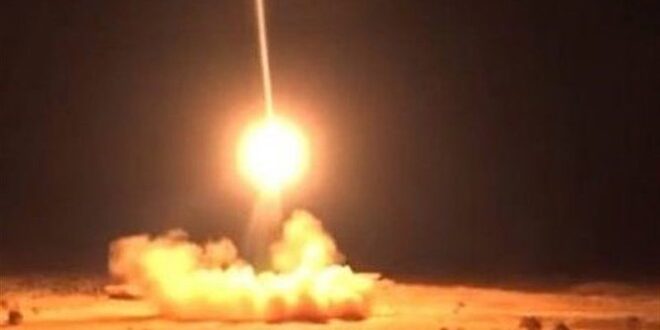Iran-backed Houthi militants launched new attacks Wednesday on merchant shipping in the Gulf of Aden, just hours after the United States carried out preemptive strikes to stave off what it said was an imminent attack on shipping lanes in the Red Sea.
U.S. Central Command, which overseas U.S. forces in the Middle East, said late Wednesday that a U.S. guided missile destroyer shot down two anti-ship ballistic missiles aimed at the M/V Maersk Detroit, a U.S.-owned and operated container ship transiting the Gulf of Aden.
A third missile fell into the sea.
U.S. officials said that while the latest attack did not cause any injuries or damage to the container ship, it shows the Houthis are not ready to back down.
“It underscores that the Houthis still intend to conduct these attacks, which means we’re, obviously, still going to do what we have to do to protect that shipping,” White House National Security Council spokesperson John Kirby told reporters at the White House.
Hours before the latest attack Wednesday, the U.S. launched preemptive strikes in Houthi-controlled Yemen, destroying two anti-ship missiles allegedly set to target international shipping in the Red Sea.
The missiles “presented an imminent threat to merchant vessels and the U.S. Navy ships in the region,” according to a U.S. Central Command statement.
The latest round of U.S. preemptive strikes and Houthi attacks follow Monday’s barrage by U.S. and British warplanes, ships and submarines aimed at degrading the ability of the Houthis to maintain their months-long assault on key shipping lanes in the region.
U.S. defense officials said Monday’s strikes hit multiple targets across eight locations, including an underground storage facility as well as missile launch sites and other locations linked to Houthi surveillance capabilities.
“These precision strikes … are in response to a series of illegal, dangerous and destabilizing Houthi actions,” the U.S. and Britain said in a statement at the time, noting the latest strikes were carried out with the support of Australia, Bahrain, Canada and the Netherlands.
U.S. officials have also signaled that while they do not seek to escalate the conflict, they are prepared to keep making the Houthis pay a price if attacks by the U.S.-designated terror group continue.
“Our hope is that we can restore security and stability to the Red Sea,” Pentagon press secretary Major General Pat Ryder told reporters Tuesday.
“If they [the Houthis] stop conducting these attacks, then there’ll be no further need to take these kinds of actions,” he added.
But in a sign of continued tensions, the United Nations confirmed Wednesday that the Houthis have given it one month to withdraw all U.S. and British staff from Houthi-controlled areas.
“What needs to be said is that any request or requirement for U.N. staff to leave — based solely on the nationality of that staff — is inconsistent with the legal framework applicable to the U.N.,” said U.N. spokesperson Stephane Dujarric.
“It also, of course, impedes our ability to deliver on the mandate to support all of the people of Yemen,” he added.
The Red Sea route carries about 15% of the world’s maritime traffic. Major shipping companies have responded to the attacks by rerouting vessels on the longer and more expensive route around Africa.
Since mid-November, the Houthis have launched at least 34 attacks on international shipping lanes, justifying them by saying they are acting in solidarity with Palestinians in Gaza under attack from Israel.
But U.S. officials say many of the Houthi attacks have targeted ships that are not associated with Israel.
The rising tensions involving the U.S., its allies, other countries and the Iran-backed Houthis in Yemen come as the U.S. also seeks to deter other Iran-backed groups in the region.
Early Wednesday, U.S. military aircraft hit Iran-backed proxies in western Iraq in response to a series of attacks against U.S. and coalition forces in recent days.
U.S. officials said the airstrikes targeted three facilities used by Kataib Hezbollah and other Iranian proxy groups in al-Qaim, Jurf al Sakhar, and one other location.
“These strikes targeted KH [Kataib Hezbollah] headquarters, storage, and training locations for rocket, missile, and one-way attack UAV [unmanned aerial vehicle] capabilities,” according to an initial statement from U.S. Central Command.
The National Security Council’s Kirby said later Wednesday that early battle damage assessments have indicated the strikes were successful.
He also further described one of the targets as an intelligence facility.
The U.S. strikes in Iraq came after one by Iran-backed militants on Ain al-Asad air base in western Iraq with one-way attack drones.
The base was also targeted Saturday by a barrage of ballistic missiles launched from inside Iraq. While most of the missiles were shot down, the Pentagon said those that landed on the base caused traumatic brain injuries in four U.S. personnel.
There have been more than 150 attacks on U.S. forces in Iraq and Syria since the October 7 Hamas terror attack against Israel, injuring at least 83 Americans, a U.S. defense official told VOA. All but two have returned to duty.
 Eurasia Press & News
Eurasia Press & News



